
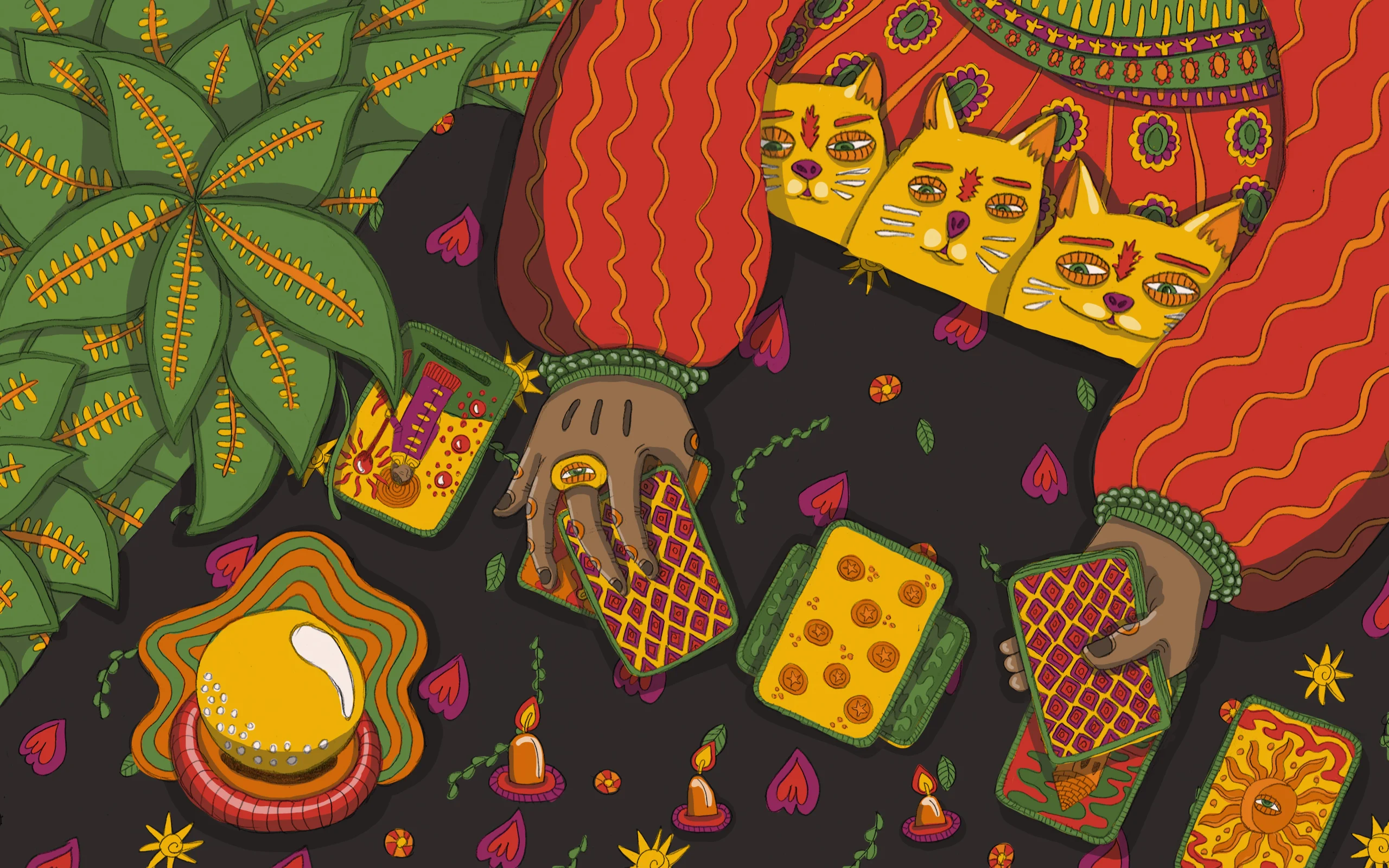
Maybe it’s a sign of the (shaky) times that a lot of people are falling back on the ancient practice of tarot in a bid to get a grip on what the hell is going on. Much like espadrilles or prawn cocktails, tarot undulates in and out of fashion but never strays far due to the malleability and potential in its artwork. New sets are designed often, and new interpretations of the cards’ meanings are always around the corner. Here, writer and occult expert Fiona Lensvelt uncovers the mysteries of the art of tarot.
Header illustration by Justyna Green

One of the first things I am asked when I tell people that I am a tarot reader is “does it work?” as though a deck of cards is an anti-wrinkle cream or a dodgy-looking thermostat. It’s always the most cynical of people who want a tarot reading to do the most gymnastic of things: reveal hidden truths, locate future partners, perhaps do a little light communication with the dead. The best way of answering that question, in my experience, is to offer them a reading. Even (especially) the hardest cynics say yes to that.
What they learn is that tarot at its core is a storytelling device, a way of framing a question or an experience we’ve had through the power of the cards. These days in certain parts of London, you might feel as though you couldn’t swing a cat without hitting a tarot reader but it’s quite the opposite of a new fad. In fact, for centuries people have turned to tarot as a way of understanding themselves and their place in the world. The French occult author and magician Éliphas Lévi went so far as to say in 1854 that he believed any person who was given tarot cards “could in a few years acquire universal knowledge.” I haven’t got that far quite yet but it’s certainly true that within the 78 cards of a standard tarot deck, you find all of life. The cards depict archetypes of individuals and situations that we will all face to a greater or lesser extent, from youthful exuberance to challenges and temptations, loss and personal growth. This is why tarot remains so relatable and relevant, despite being created centuries ago. It has the power to tackle the big questions we all face.
Tarot remains so relatable and relevant, despite being created centuries ago. It has the power to tackle the big questions we all face.
But does it work? For many querents (the person you are reading for; it means “one who seeks”) there is a value and magic in seeing your own situation reflected back at you through a random selection of cards. Think of it like you would a Rorschach test: I present you with symbols and explain their meaning but what you see will be different to what the next person sees. You do not need to believe in fortune telling to find power in a reading. As the psychotherapist Carl Jung said, “We can predict the future, when we know how the present moment evolved from the past.”
Tarot may be over 600 years old but it’s no arcane tool: it is one of the most flexible magical practices out there, adapting for every era. One of the most exciting ways it does this is through art. Illustrators, occultists and myriad others have imagined and reimagined the archetypes found on the cards to create new tarot decks that reflect their times. A deck is “a talking mirror allows us to see and understand more about ourselves,” writes Jessica Hundley in Divine Decks: A Visual History of Tarot (Taschen, 2020), a book that explores how the cards have been interpreted by artists, mystics and myriad others through the ages. “What is hidden in the imagery of tarot reflects the hidden in ourselves.”
Different symbols and images resonate in different times, while others take on new meaning. Here are 10 examples of old and new Major and Minor arcana cards to show you what I mean.
Visconti-Sforza (15th Century)
Love/The Lovers
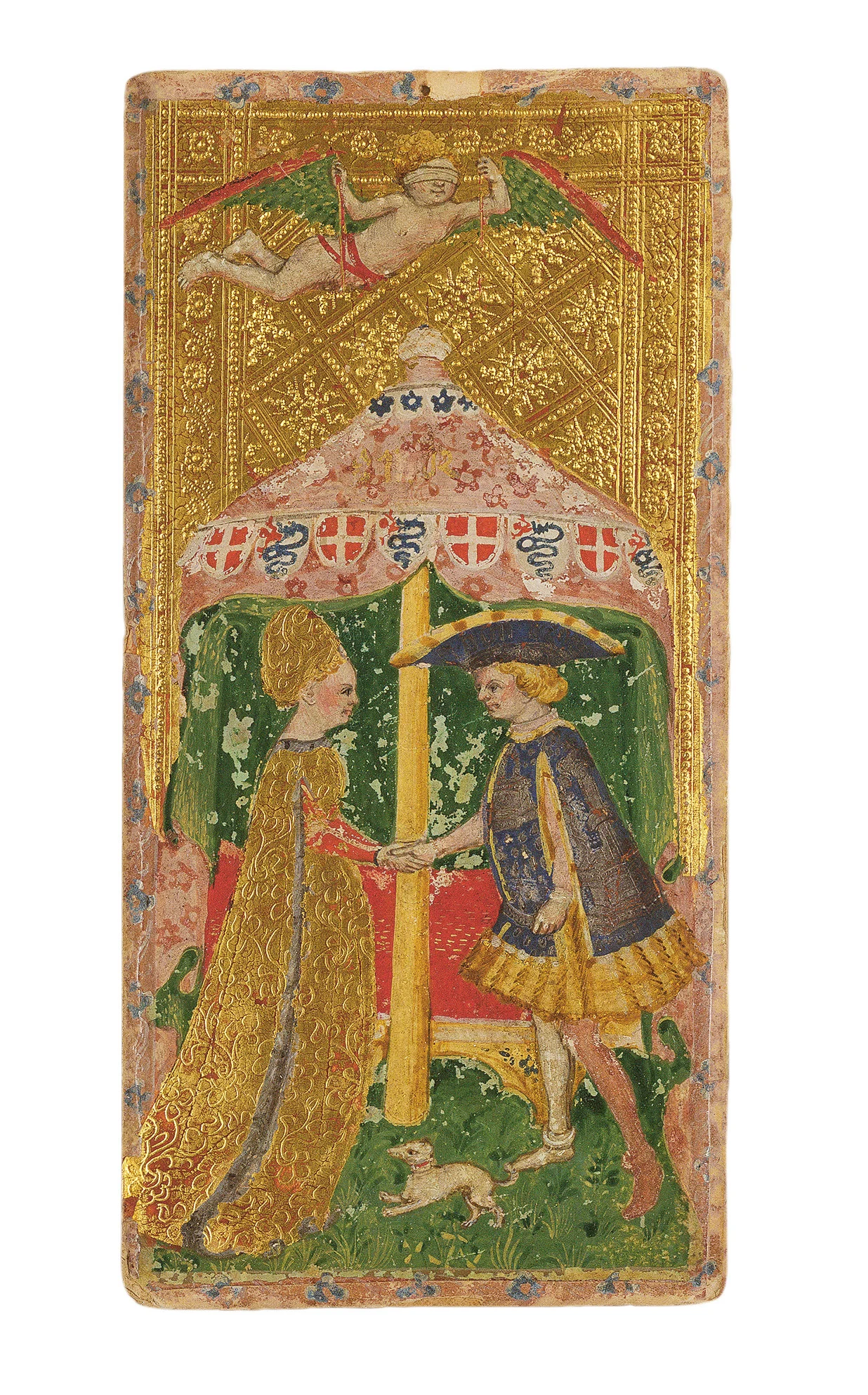
Whenever someone comes for a tarot reading, there is one subject you can guarantee they want to know about: love. Just as people look worried when they pull the Death card, they are delighted when The Lovers turn up. But the appearance of this amorous pair doesn’t necessarily mean romance is on the cards.
The oldest-known tarot cards are referred to as the Visconti-Sforza, which are believed to have been commissioned by Filippo Maria Visconti, the Duke of Milan, and his son-in-law Francesco Sforza to play the card game Trionfi. Hand painted and gilded in gold leaf, these decks were given as gifts for weddings and used as a storytelling aid or, in some cases, were used as a method of critique at court “not unlike the antics of the jester,” says Jessica Hundley in Divine Decks: A Visual History of Tarot. It wasn’t until the 16th Century that tarot began to be known as a divinatory tool.
The symbols that appeared on early tarot decks often reflected a renewed interest in Christian mysticism and Greek and Roman mythology. For example, in Love, we see two people standing before a column with a winged, blindfolded cupid standing on top, uniting the pair. The “Love” card isn’t purely romantic, as the later card the Lovers might suggest: it can be about relationships in a broader sense, about clear communication, your passions and it can ask whether you are being authentic to yourself.
Autonomic Tarot by Sophy Hollington and David Keenan (2018)
Cups (Beginning)

From occult chimera to dildos piercing the sky and psychedelic, intergalactic shoes, the 30-card linocut Autonomic Tarot by illustrator Sophy Hollington and writer David Keenan retains “an umbilical to the card’s archaic roots, yet future-visions it as a glam-punk portal deep into the Now.”
In Cups (Beginning), the card depicts a figure that looks like it is throwing a glass of wine in someone’s face, David Keenan tells me. “It relates to finding your true self, outside of ideas of who you are that have been ‘received’ from others, especially friends, partners, and family. However, the injunction is to avoid rejecting all of it, and seeing what part of it is your own uniquely gifted experience. Keep that and use the energy of the rejected material to fly higher on your own.”
In the alchemical vessel, there is a phoenix rising. “In certain birds there can occur a genetic mutation that means they grow a second subsidiary wing, known as a bastard wing,” says David. “This allows them to fly even higher.”
The Motherpeace Tarot by Karen Vogel and Vicki Noble (1981)
The Fool
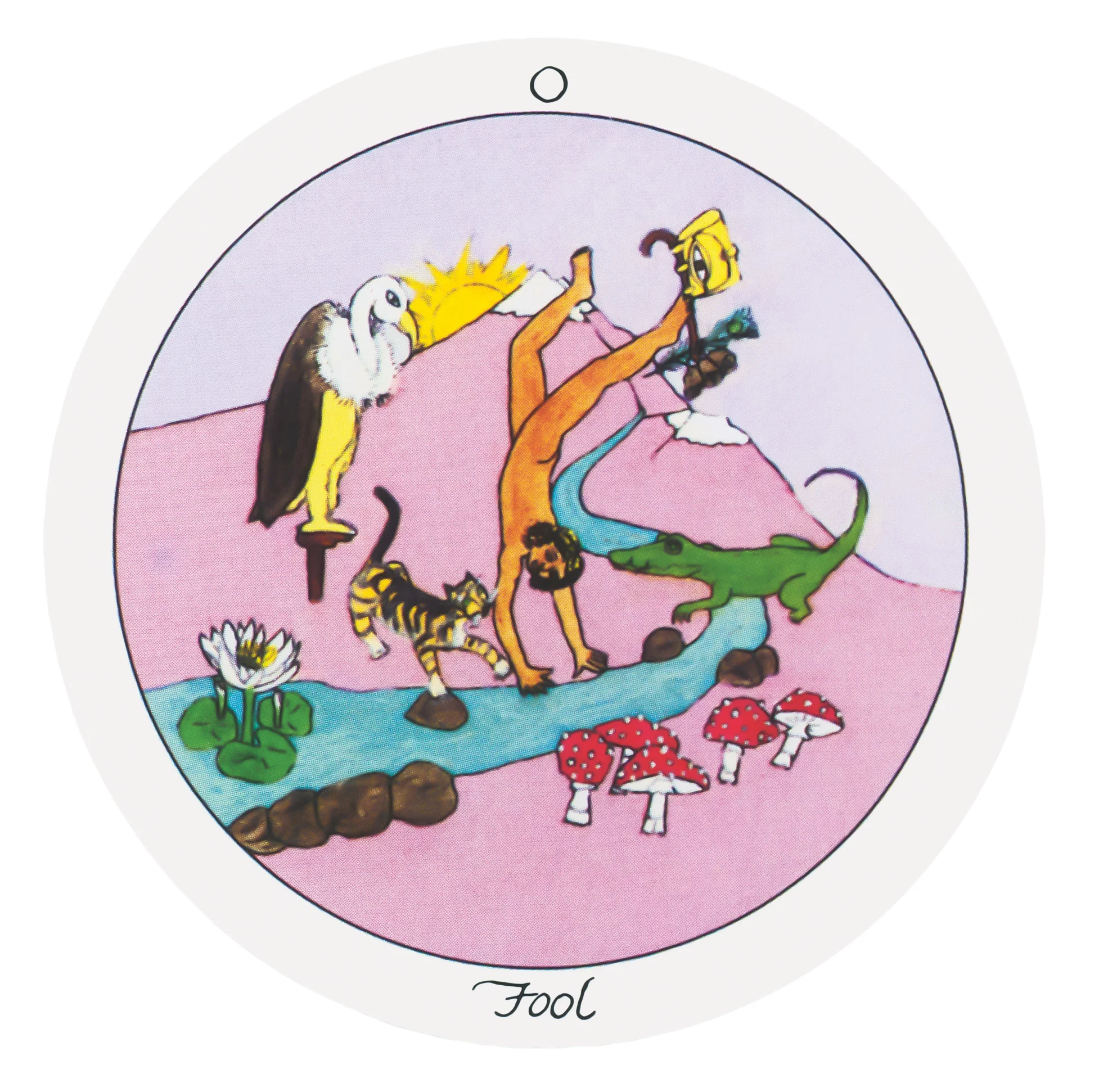
Tarot is divided into the Major and Minor Arcana, arcana meaning “secrets.” The 22 cards of the Major Arcana tell the story of the hero’s journey. It is a narrative that has been told time and time again from the Bible to Star Wars. As the professor of literature and comparative mythology Joseph Campbell described it: “A hero ventures forth from the world of common day into a region of supernatural wonder: fabulous forces are there encountered and a decisive victory is won: the hero comes back from this mysterious adventure with the power to bestow boons on his fellow man.” This journey begins with the Fool.
The Motherpeace tarot, which inspired a recent Dior collection, draws on strong female archetypes. Karen Noble and Vicki Vogel researched the goddess-based cultures around the world. Here, the Fool is expressed as a childlike figure, who is crossing a river by walking on their hands. Does she show any fear of the crocodile swimming nearby? No she does not and nor should you. Metaphorically, at least. Take a leap into the unknown.
Spolia by Jen May and Jessa Crispin (2018)
Wheel of Fortune
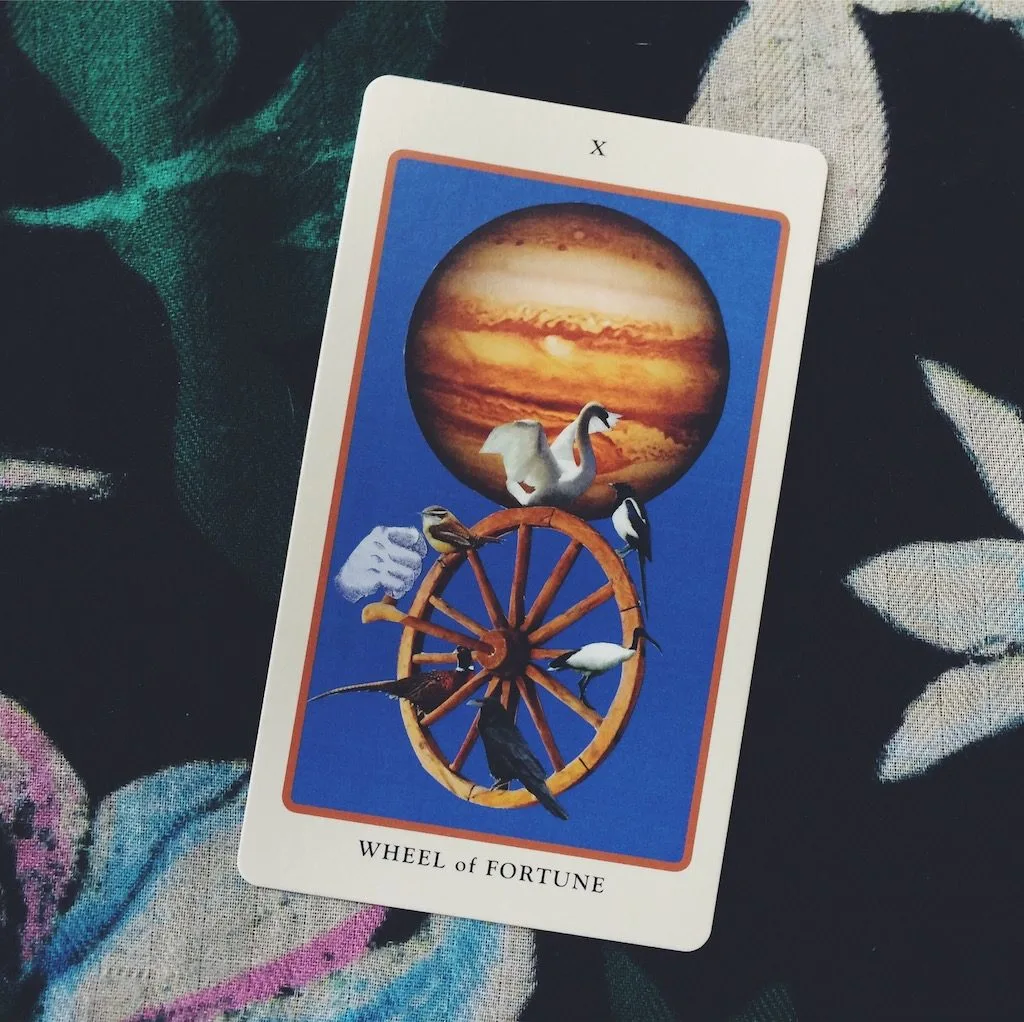
Tarot is not some trick that reveals when you might meet a handsome lover or how to get a promotion. It’s a method of guiding your attention to create the change you want in your life. But the appearance of the Wheel of Fortune in a reading can be a bit of a slap in the face to that idea. As Jessa Crispin explains in her tarot newsletter, there’s free will and then there’s fate. And the Wheel of Fortune is most definitely fate, throwing your best laid plans into disarray. Yet there’s hope. Jessa, who is familiar with astrology, adds an image of Jupiter to her version of the card, which connotes growth and expansion.
The word “spolia” refers to repurposed building stone for new construction, which is exactly what this collage tarot deck does by reimagining the Rider-Waite-Smith deck. It is also, as Jessa has pointed out, a fitting term for the times we are living in as gender norms, belief systems and ideas about how a society should function tumble down and are rebuilt.
Untitled, Tom Maryniak (2020)
The Hermit

Not all tarot decks are to be taken seriously. This humorous Major Arcana series takes as its inspiration the great British pub crawl. Imagine the Fool representing the infinite potential of the night ahead, the Magician is your publican who can manifest any drink of your choosing, while Judgement arrives in the cold, harsh light of the morning after.
Traditionally, the Hermit represents a period of introspection where you are drawing your attention inwards to seek answers from within. In this deck, we find him “already half cut and taking a moment outside a bar for himself, cigarette in hand as the revelry continues inside behind him,” says the illustrator Tom Maryniak. This hermit doesn’t always need to stick with the group: he dances to the beat of his own drum.
The Rider-Waite Smith deck, illustrated by Pamela Colman-Smith (1910)
Queen of Swords
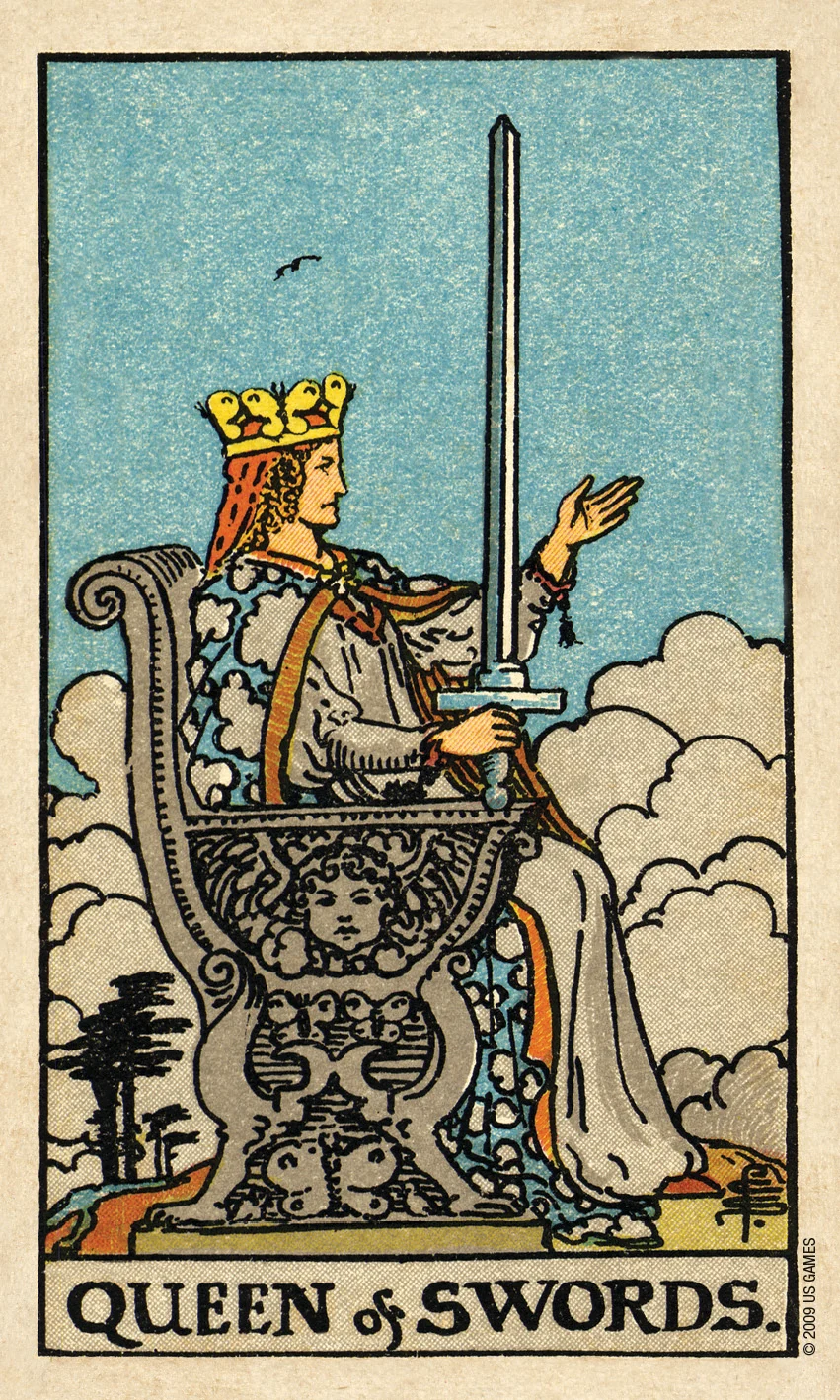
On the surface, the Queen of Swords is your no-nonsense business woman. Someone who will speak her mind, who follows the head over the heart and is guided by her own North Star. She’s endured sorrow and survived it. She is strong, she is independent...she's basically Beyoncė in Coachella mode.
This depiction of the card comes from the Rider-Waite-Smith, the world’s most popular tarot deck. When the artist, folklorist and occultist Pamela Colman-Smith completed the 78 cards in 1909, she described it as “a big job for very little cash!”
The mythical images she created are threaded through with Christian symbolism and draw us into a world of kings and queens, brave knights and maidens who tame lions, castles and gardens, magicians and devils, adventure and peril. Look closely and you will notice that many of the cards resemble theatrical stages. Colman-Smith was orphaned as a teenager and taken under the wing of the renowned actress Ellen Terry, who ran the Lyceum Theatre in the West End of London. When she came to illustrate the Queen of Swords, she had to find someone to inspire the figure’s face who perhaps embodied the card’s values. That person was Ellen.

